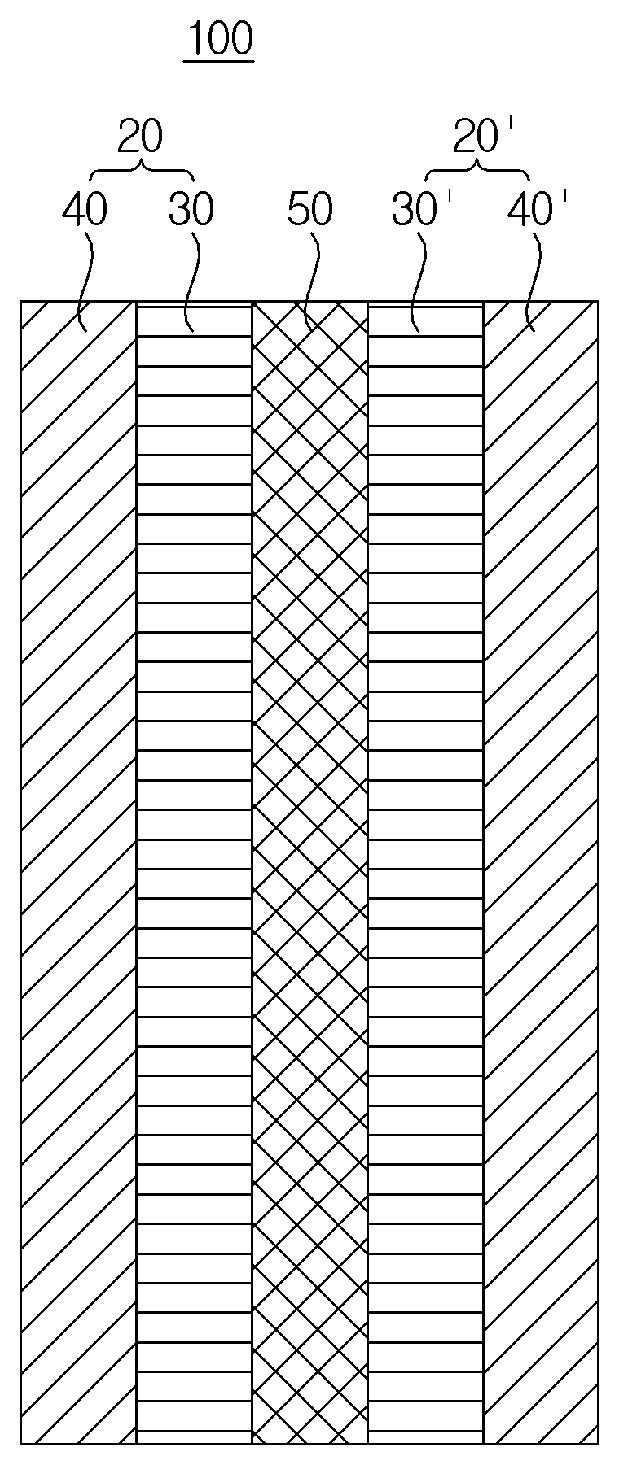Polymer electrolyte membrane, method for fabricating same, and membrane-electrode assembly comprising same
a polymer electrolyte and membrane technology, applied in the direction of cell components, final product manufacturing, sustainable manufacturing/processing, etc., can solve the problems of increasing ohmic loss, reducing energy conversion efficiency, and requiring large quantities of expensive materials, so as to improve mechanical properties, improve dimensional stability, and reduce the effect of membrane resistan
- Summary
- Abstract
- Description
- Claims
- Application Information
AI Technical Summary
Benefits of technology
Problems solved by technology
Method used
Image
Examples
production example 1
[0170]4,4-Biphenol (BP) and K2CO3 were introduced together with N-methyl-2-pyrrolidone (NMP) and toluene into a four-necked round bottom flask equipped with a Dean-Stark trap, and while the mixture was stirred with a mechanical stirrer, the temperature was slowly increased to 150° C. over a period of about 2 hours. Toluene began to be refluxed at the temperature of 150° C. through the Dean-Stark trap, and thus toluene was removed by maintaining the refluxing condition for about 4 hours. Dried SDCDS (3,3-disulfonated-4,4-dichlorodiphenylsulfone) and DCDPS (4,4-dichlorodiphenylsulfone) were weighed in a glove box, and were introduced into the reactor together with NMP. The temperature was slowly increased to 195° C., and the system was stirred for 16 hours. After polymerized was completed, the product was immersed in water, and salts were removed at 100° C. for 2 hours. The filtrate obtained by filtering the resultant was dried, and thus sulfonated polyarylene ether su...
production example 2
Ether Ketone-Ether Sulfone Random Copolymer
[0171]BP and K2CO3 were introduced together with NMP and toluene into a four-necked round bottom flask equipped with a Dean-Stark trap, and while the mixture was stirred with a mechanical stirrer, the temperature was slowly increased to 150° C. over a period of about 2 hours. Toluene began to be refluxed at the temperature of 150° C. through the Dean-Stark trap, and thus toluene was removed by maintaining the refluxing condition for about 4 hours. Dried SDCDS, DCDPS, and phenol,4,4-(1,3-dioxolan-2-ylidene)bis- (Cas No. 91998-26-4, manufactured by Yanjin Technology Co., Ltd.) were weighed in a glove box, and were introduced into the reactor together with NMP. The temperature was slowly increased to 195° C., and the system was stirred for 16 hours. After polymerized was completed, the product was immersed in water, and salts were removed at 100° C. for 2 hours. The filtrate obtained by filtering the resultant was dried, and thus a sulfonated ...
production example 3
Ether Ketone-Ether Sulfone Block Copolymer
[0172]BP and K2CO3 were introduced together with NMP and toluene into a four-necked round bottom flask equipped with a Dean-Stark trap, and while the mixture was stirred with a mechanical stirrer, the temperature was slowly increased to 150° C. over a period of about 2 hours. Toluene began to be refluxed at the temperature of 150° C. through the Dean-Stark trap, and thus toluene was removed by maintaining the refluxing condition for about 4 hours. Dried SDCDS (3,3-disulfonated-4,4-dichlorodiphenylsulfone) was weighed in a glove box, and was introduced into the reactor together with NMP. The temperature was slowly increased to 195° C., and the system was stirred for 16 hours. After polymerized was completed, the product was immersed in water, and salts were removed at 100° C. for 2 hours. The filtrate obtained by filtering the resultant was dried, and thus a first polymer was produced.
[0173]Next, a second polymer was produced in the same mann...
PUM
| Property | Measurement | Unit |
|---|---|---|
| temperature | aaaaa | aaaaa |
| operating temperature | aaaaa | aaaaa |
| size | aaaaa | aaaaa |
Abstract
Description
Claims
Application Information
 Login to View More
Login to View More - R&D
- Intellectual Property
- Life Sciences
- Materials
- Tech Scout
- Unparalleled Data Quality
- Higher Quality Content
- 60% Fewer Hallucinations
Browse by: Latest US Patents, China's latest patents, Technical Efficacy Thesaurus, Application Domain, Technology Topic, Popular Technical Reports.
© 2025 PatSnap. All rights reserved.Legal|Privacy policy|Modern Slavery Act Transparency Statement|Sitemap|About US| Contact US: help@patsnap.com



